Hypothyroidism-Statins Risk Assessment Tool
Your Risk Assessment
Enter your thyroid function and current statin type to see your risk level
When you’re managing both hypothyroidism and high cholesterol, taking statins can feel like walking a tightrope. On one side, you need to protect your heart. On the other, you’re at risk of severe muscle damage-something many patients and even some doctors don’t connect to thyroid function. The truth is, if your thyroid isn’t properly treated, statins can turn from life-saving medicine into a dangerous threat.
Why Hypothyroidism Makes Statins Riskier
Statins lower cholesterol by blocking an enzyme in your liver. But they also interfere with how your muscles produce energy. That’s usually fine for healthy people. But when you have hypothyroidism, your body’s already struggling to generate energy at the cellular level. Your mitochondria-the powerhouses inside your muscle cells-run slower. Add statins into the mix, and they cut coenzyme Q10 levels by 25-50%. That’s like turning down the fuel supply to an engine that’s already running on fumes.
On top of that, hypothyroidism slows down how your liver breaks down statins. The enzymes responsible-especially CYP3A4-don’t work as well. That means more of the drug stays in your bloodstream. For statins like simvastatin and atorvastatin, levels can jump 30-50%. Higher drug concentration + weaker muscles = much higher chance of muscle pain, weakness, or worse.
The Real Danger: Rhabdomyolysis
Most people think statin side effects mean mild soreness. But in hypothyroid patients, the risk of rhabdomyolysis-a life-threatening breakdown of muscle tissue-goes up dramatically. When muscle cells die, they dump creatine kinase (CK) into the blood. Normal CK levels are under 200 U/L. In rhabdomyolysis, they can hit 15,000, 20,000, even over 28,000 U/L. That overwhelms your kidneys. Without quick treatment, you can need dialysis.
A 2023 case report in Cureus described a 67-year-old woman who developed rhabdomyolysis with CK levels of 28,500 U/L while on simvastatin 40 mg daily. Her TSH? A staggering 22.4 mIU/L. She was preparing for radioactive iodine therapy and hadn’t adjusted her thyroid meds. She ended up in intensive care. This isn’t rare. Studies show hypothyroid patients on statins are 4-5 times more likely to develop severe muscle injury than those with normal thyroid function.
Not All Statins Are Created Equal
If you have hypothyroidism, the type of statin you take matters just as much as the dose. Lipophilic statins-like simvastatin, atorvastatin, and lovastatin-easily slip into muscle tissue. That’s why they carry the highest risk. Hydrophilic statins, like pravastatin and rosuvastatin, stay mostly in the liver and are much gentler on muscles.
Here’s what the data shows:
| Statin | Type | Myopathy Risk in Hypothyroid Patients | Recommended Dose |
|---|---|---|---|
| Simvastatin | Lipophilic | 12.7% incidence at ≥40 mg/day | Avoid ≥40 mg; not recommended |
| Atorvastatin | Lipophilic | 3.2-fold increased risk | Use low dose (10-20 mg) |
| Rosuvastatin | Hydrophilic | 1.4-fold increased risk | Preferred: 10-20 mg/day |
| Pravastatin | Hydrophilic | 1.3% incidence | Lowest risk option |
The 2022 American College of Cardiology guidelines now explicitly warn against high-dose simvastatin in hypothyroid patients. Rosuvastatin and pravastatin are the clear winners here. If you’re on simvastatin and have hypothyroidism, talk to your doctor about switching.
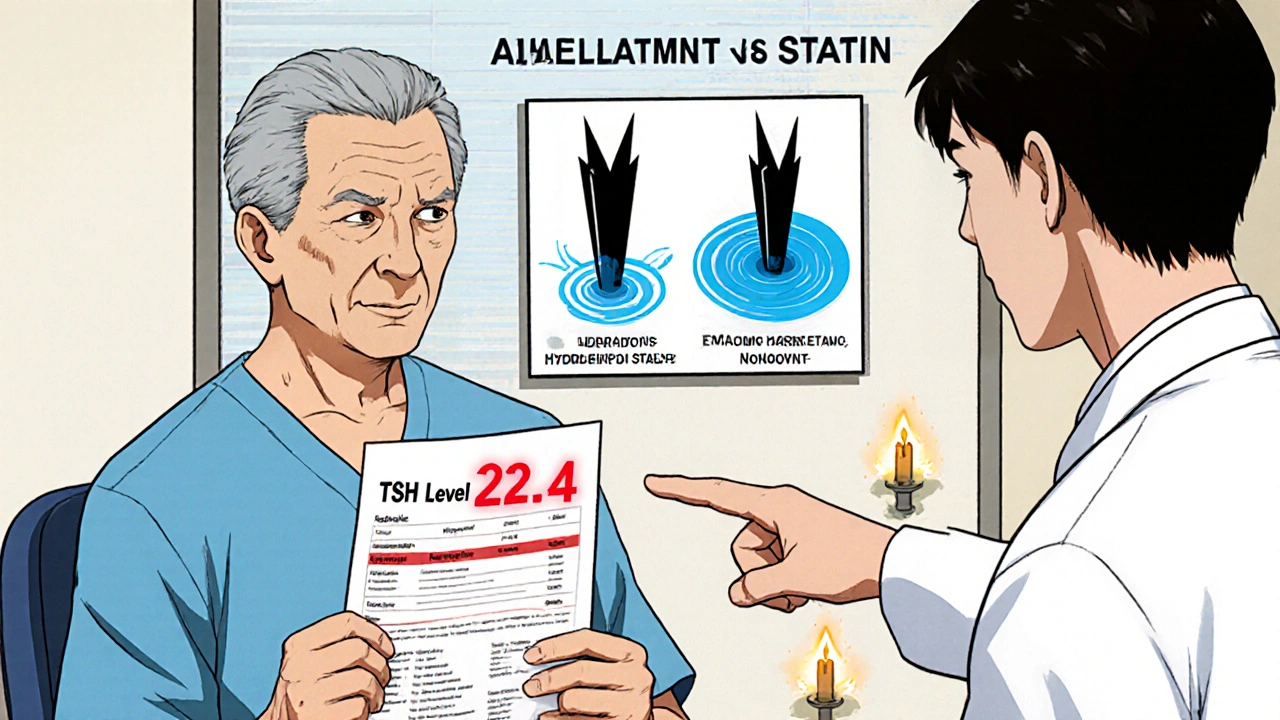
Thyroid Levels Are the Key
It’s not enough to just take your levothyroxine. You need to know your TSH level-and keep it in the sweet spot. The old target of TSH under 5.0 mIU/L is outdated. New guidelines from the American Thyroid Association (2023) and Endocrine Society say: aim for 0.5-3.0 mIU/L.
Why? Because risk climbs sharply above 4.0 mIU/L. A 2019 study of over 12,000 patients found:
- TSH 4.5-10 mIU/L: 2.1 times higher risk of myopathy
- TSH >10 mIU/L: 4.2 times higher risk
- TSH >20 mIU/L: Near 5-fold increase in rhabdomyolysis risk
One Reddit user, HypoWarrior2022, shared their story: CK hit 8,400 U/L after starting atorvastatin while their TSH was 9.2. After adjusting their thyroid meds and waiting six weeks, symptoms vanished. That’s the pattern: fix the thyroid first, then restart the statin.
Dr. Paul W. Ladenson from Johns Hopkins says treating hypothyroidism before starting statins reduces myopathy risk by 78%. That’s not a small number. It’s the difference between being safe and being hospitalized.
What You Should Do Right Now
If you have hypothyroidism and are on-or thinking about starting-a statin, here’s your action plan:
- Get your TSH and free T4 tested before starting any statin. Don’t assume your thyroid is fine because you take medication.
- If TSH is above 4.0 mIU/L, work with your doctor to adjust your levothyroxine. Don’t rush-dose changes should be spaced 4-6 weeks apart.
- Once TSH is between 0.5 and 3.0 mIU/L, start a low-dose hydrophilic statin (rosuvastatin or pravastatin).
- Get a baseline CK test. Repeat at 3 months, and again if you feel new muscle pain, weakness, or dark urine.
- Stop the statin and call your doctor if CK rises above 10 times the upper limit of normal, or above 5 times with symptoms.
And don’t skip the supplement talk. A 2020 trial showed 200 mg of coenzyme Q10 daily reduced muscle pain by over 50% in hypothyroid statin users. It’s not FDA-approved for this use, but many endocrinologists recommend it. Talk to your doctor-it’s safe and low-cost.
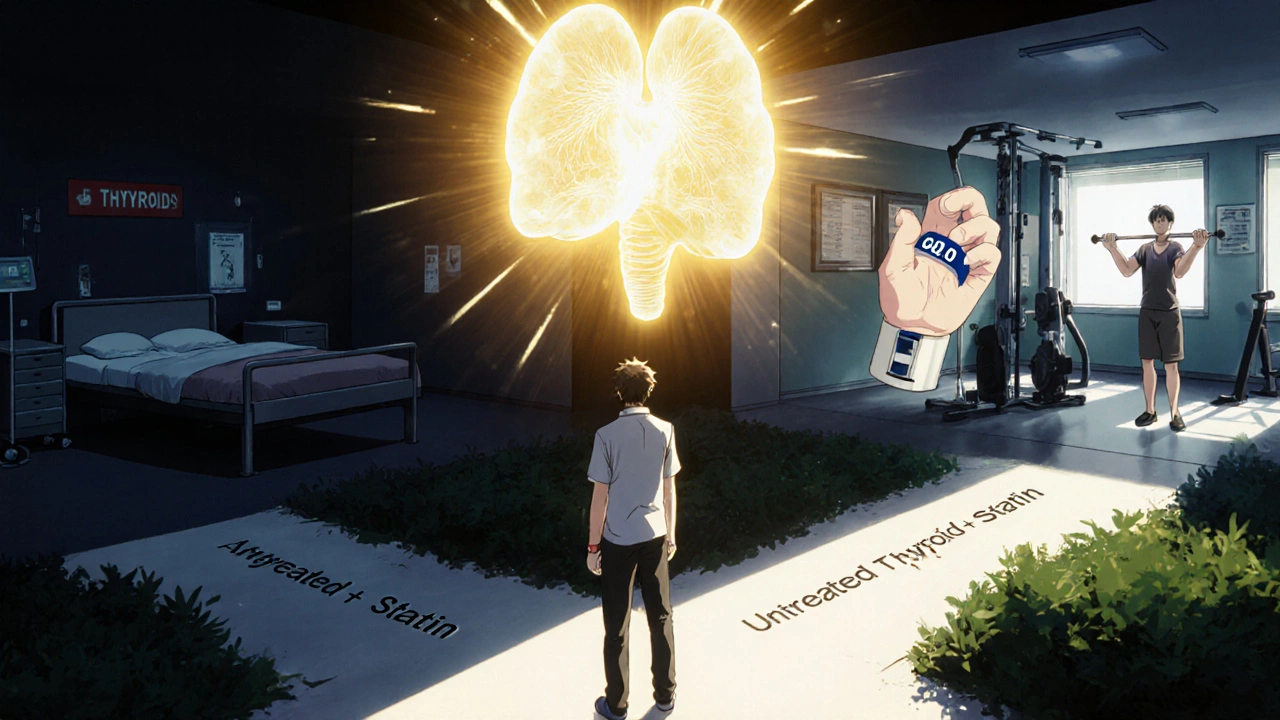
The Bigger Picture: Why This Matters
Over 20 million Americans have hypothyroidism. Nearly 40 million take statins. That means millions are at risk without even knowing it. A 2022 study found 32% of hypothyroid patients quit their statins within a year because of muscle pain. That’s not laziness-it’s fear after a bad experience. But here’s the twist: when thyroid levels are optimized, 85-90% of those patients can safely stay on statins.
Stopping statins because of muscle pain is dangerous. The real threat isn’t the statin-it’s the untreated thyroid. Without statins, heart attacks and strokes go up. With proper thyroid management, those risks drop back to normal.
Recent research is even more promising. A 2023 study in Nature Medicine found a genetic test combining thyroid and SLCO1B1 gene markers can predict statin myopathy risk with 82% accuracy. Soon, doctors may be able to pick the right statin for you based on your DNA and thyroid status. But that’s still ahead. Right now, the best tool you have is a simple blood test: TSH.
Final Thought: Don’t Choose Between Your Heart and Your Muscles
You don’t have to give up statins because you have hypothyroidism. You just need to treat your thyroid properly first. Too many people suffer muscle pain, stop their meds, and then wonder why their cholesterol is back up. The answer isn’t quitting statins-it’s fixing the root cause.
Take control. Get your TSH checked. Talk to your doctor about switching statins. Consider CoQ10. Don’t let fear stop you from protecting your heart. With the right approach, you can have both healthy cholesterol and healthy muscles.
Can hypothyroidism cause muscle pain even without statins?
Yes. Hypothyroidism itself can cause muscle stiffness, cramps, and weakness because low thyroid hormone slows down muscle metabolism and reduces energy production. Many people mistake this for aging or inactivity. If you have unexplained muscle pain and haven’t checked your thyroid in over a year, get tested.
Should I stop my statin if I feel muscle soreness?
Not immediately. Mild soreness is common and often temporary. But if the pain is new, worsening, or accompanied by dark urine, fatigue, or weakness, get your CK levels checked. Never stop statins without talking to your doctor-they may just need to adjust your dose or switch you to a safer type.
Is it safe to take CoQ10 with levothyroxine?
Yes. CoQ10 has no known interaction with levothyroxine. Many endocrinologists recommend 200 mg daily for hypothyroid patients on statins. Take it with food for better absorption. It’s not a cure, but it can reduce muscle symptoms by more than half in clinical trials.
How often should I get my TSH checked if I’m on statins?
Test TSH before starting a statin. Then check again 6-8 weeks after starting or changing your statin dose. If your thyroid levels are stable, annual testing is usually enough-but if you develop muscle symptoms, retest immediately. TSH can drift over time, especially with age or changes in medication.
Can I switch from simvastatin to rosuvastatin safely?
Yes, and it’s often the best move for hypothyroid patients. Rosuvastatin is less likely to cause muscle issues. Your doctor will match the cholesterol-lowering effect-usually 10-20 mg of rosuvastatin equals 20-40 mg of simvastatin. Don’t switch on your own; get your TSH and liver enzymes checked before and after.
What if my TSH is normal but I still have muscle pain on statins?
You may have subclinical hypothyroidism or another factor-like vitamin D deficiency, genetic variants (SLCO1B1), or kidney issues. Ask your doctor for a full workup: free T4, TPO antibodies, vitamin D, CK, and possibly genetic testing. Sometimes, switching to pravastatin or lowering the statin dose helps.


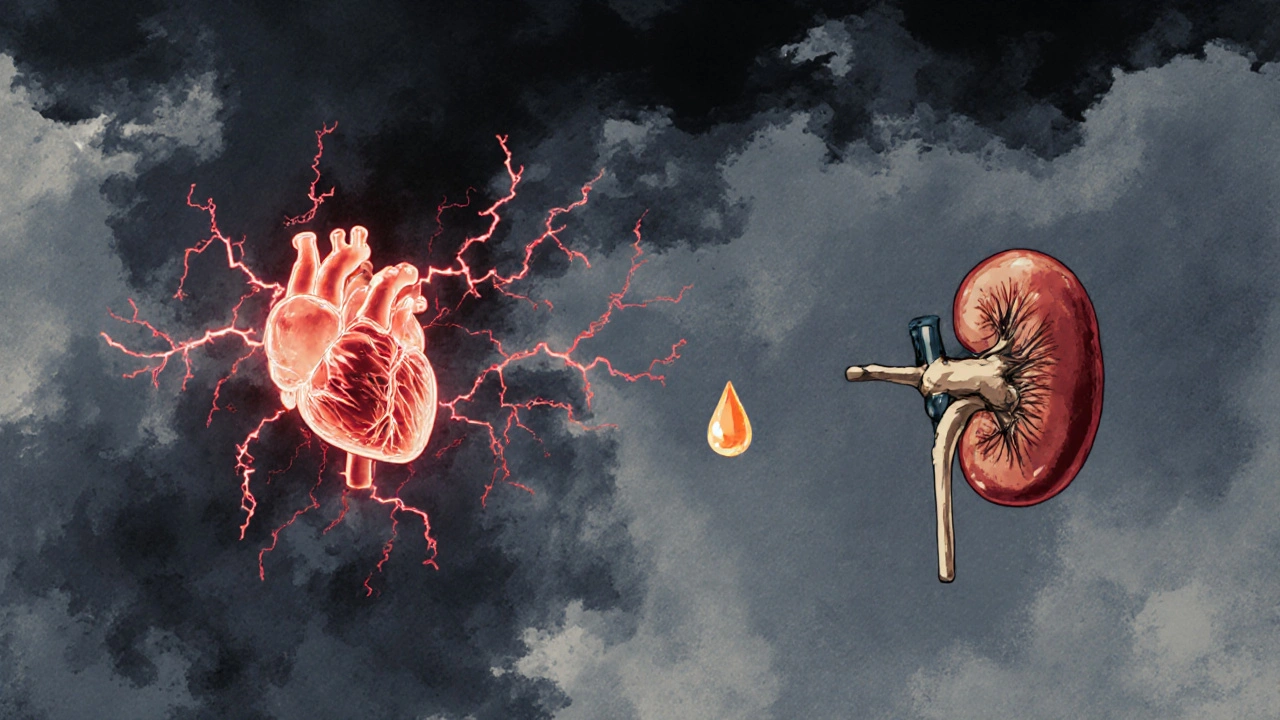


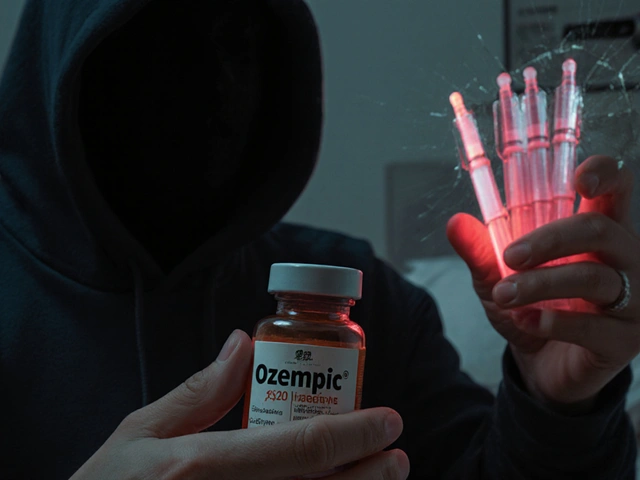


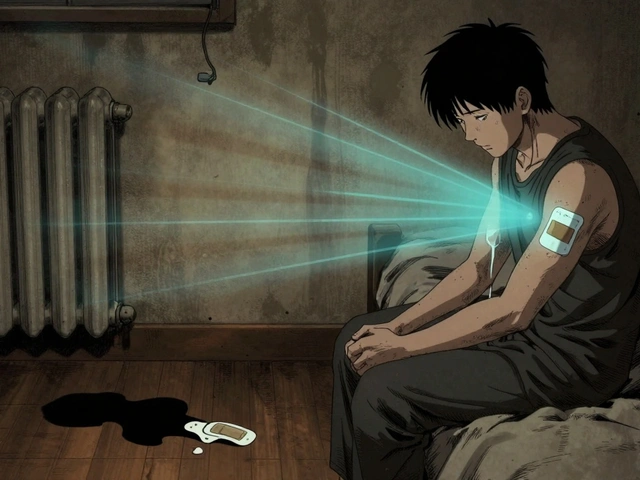
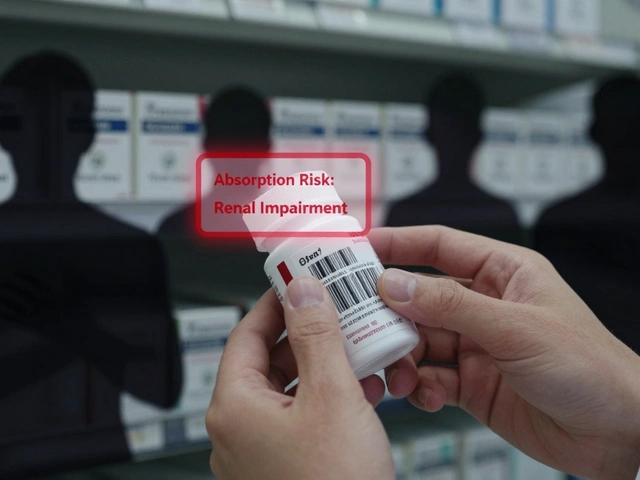
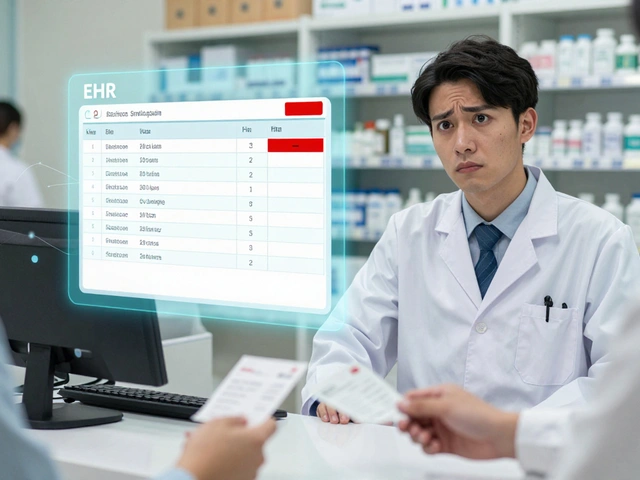
Manjistha Roy
22 Nov 2025 at 12:54This is one of the most important posts I’ve read all year. I was on simvastatin for years and had constant muscle pain I blamed on aging. Turns out my TSH was 8.7. Once I got it down to 2.1 and switched to rosuvastatin, the pain vanished. No more guessing. Test your TSH. It’s that simple.
Doctors need to stop treating thyroid and cholesterol as separate issues. They’re linked. Your heart and your muscles depend on both being balanced.